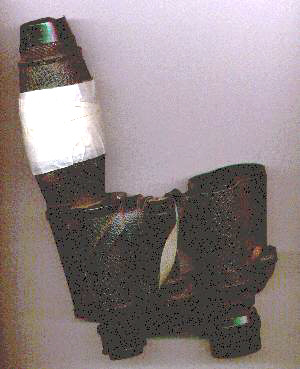Open your eyes and see a new level of movement and energy! In the world's best laboratory - en vivus1 - en natura1! With this cheap new tool, you have an enlarged view of moving reptilian scales on a lizard, a curling/unfurling tongue of a butterfly as it eats pollen on the stamen of a flower, a fly cleaning itself, and the individual crystals of minerals, sugar and salt. And you don't have to kill the object of your affections to be up close and personal - or be tied to a flat table with a bright light in your face. And you can do science everywhere - including when the weird-looking creatures are moving! The tool - it's cheap and quick to assemble. It's a monocular microscope2.
For less than $20 (at a local pawn shop, start by offering $5 ), you can buy a pair of binoculars ($35 new at the mall). Or you can use moldy dusty antiques from your attic (or your dad's old pair - but get his OK first, please). Facing the binoculars (that's the "not looking through the eyepiece" end), lefty-loosey (unscrew counterclockwise) the easier of the two objective lens mounts (i.e. about midway along the binoculars, the lens mount at the looking-out end is way harder to unscrew). Reverse the optical component - take the butt end off the binocular (not the screw-in part of the lens), flip it over and place it on the other butt end (that is, reverse the optical component) and tape the two ends together.
It should wind up looking something like this:
| (Note: this modification is only suitable for larger binoculars where the objective is fitted to the end of a conical mount which screws into the prism casing). |
 |
Now, while looking through the one good optic lens (this half is now the monocular microscope) hold your hand from 4" to 6" away from the last piece of glass. Move your hand back and forth until it is in focus and, bingo, you are using a portable monocular microscope - a tool well suited for viewing virtually all living objects. Run around and look at things from this new perspective. Don't be shy - this is a time to jump with puppy-dog enthusiasm. Draw pictures of this new dimension of life that you are seeing for the first time and impress yourself (not to mention friends and relatives).
What? You've never heard of this neat tool? Neither has hardly anyone else. Don't be embarrassed - science is full of these super-neat surprises. And don't think this is the only neat thing (that could change your life or open new horizons) to be found here - there are more gems hidden throughout the web site. And we will continue to add these gems (or are they mere baubles?), so please come every month or so just to see what is new.
| Image of a beetle captured through the 'scope. The beetle's face was captured with a tiny video camera that plugs into my computer. Anything you see can become a superb photomicrograph by aligning your camera to capture the image coming out of the monocular microscope's eyepiece. |
 |
Now, if perchance you want to view distant objects again, remove the tape and put the male screw end back in its original position on the female component. Threading these highly precise screws requires a delicate backthreading (lefty-loosey until the threads click into place - it may take one or two complete revolutions) then righty-tighty (screw clockwise) gently until the lens is back snug in its original home. Crossthreading ruins everything and should be avoided at all costs. There should be no resistance as this is screwed back together. If you're not sure, backthread it again - this process should be as smooth as a mosquito's proboscis. Another hint would be to look at the binocular from the side - to make sure the binocular body sits perfectly parallel to the screw threads and the objective lens.
Comments to the author
Jim
Disbrow are welcomed.
End Notes:
1. Latin expressions: En vivus - "in a living system - alive". En natura - "in nature".
2. Parts list: one pair of binoculars, 8 inches of tape (any kind will do), weird things to look at.